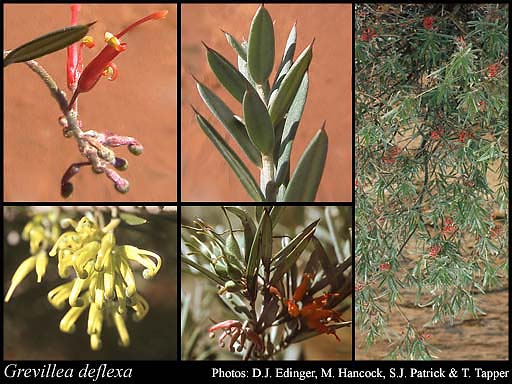- Reference
- Australas.Chem.Druggist Suppl. 5:72 (1883)
- Conservation Code
- Not threatened
- Naturalised Status
- Native to Western Australia
- Name Status
- Current
Stiff, spreading or rarely procumbent shrub, (0.1-)0.2-1.5(-2) m high. Fl. red/yellow, May to Oct. Red sand, red sandy loam, alluvium.

Scientific Description
Shrubs, 0.5-2 m high; branchlets hairy, not glaucous. Leaves alternate, 20-75 mm long, 1-10 mm wide, hairy, on the adaxial or abaxial surface, the hairs straight; lamina flat, more or less the same width throughout, entire, the margins recurved or revolute, exposing the lower surface of the leaf blade or enclosing the lower surface of the leaf blade. Inflorescences axillary or cauline, yellow or red; pedicels 5-7 mm long. Perianth 14-18 mm long; tepals all free after flower opens, hairy, simple-hairy; ovary hairy, stipitate, the stipe 1.5-2 mm long; pistil 18-25 mm long, red, pollen presenter lateral, style glabrous. Follicles hairy, not viscid, dehiscent, 13-15 mm long. Flowers in May, June, July, August, September or October. Occurs in the Eremaean (ER) or South-west (SW) Botanical Province(s), in the Carnarvon (CAR), Gascoyne (GAS), Yalgoo (YAL), Murchison (MUR) or Avon Wheatbelt (AW) IBRA subregion(s).
Distribution
- IBRA Regions
- Avon Wheatbelt, Carnarvon, Gascoyne, Geraldton Sandplains, Murchison, Yalgoo.
- IBRA Subregions
- Augustus, Carnegie, Eastern Murchison, Geraldton Hills, Merredin, Tallering, Western Murchison, Wooramel.
- Local Government Areas (LGAs)
- Cue, Laverton, Leonora, Meekatharra, Menzies, Morawa, Mount Magnet, Murchison, Northampton, Perenjori, Sandstone, Shark Bay, Upper Gascoyne, Wiluna, Yalgoo.